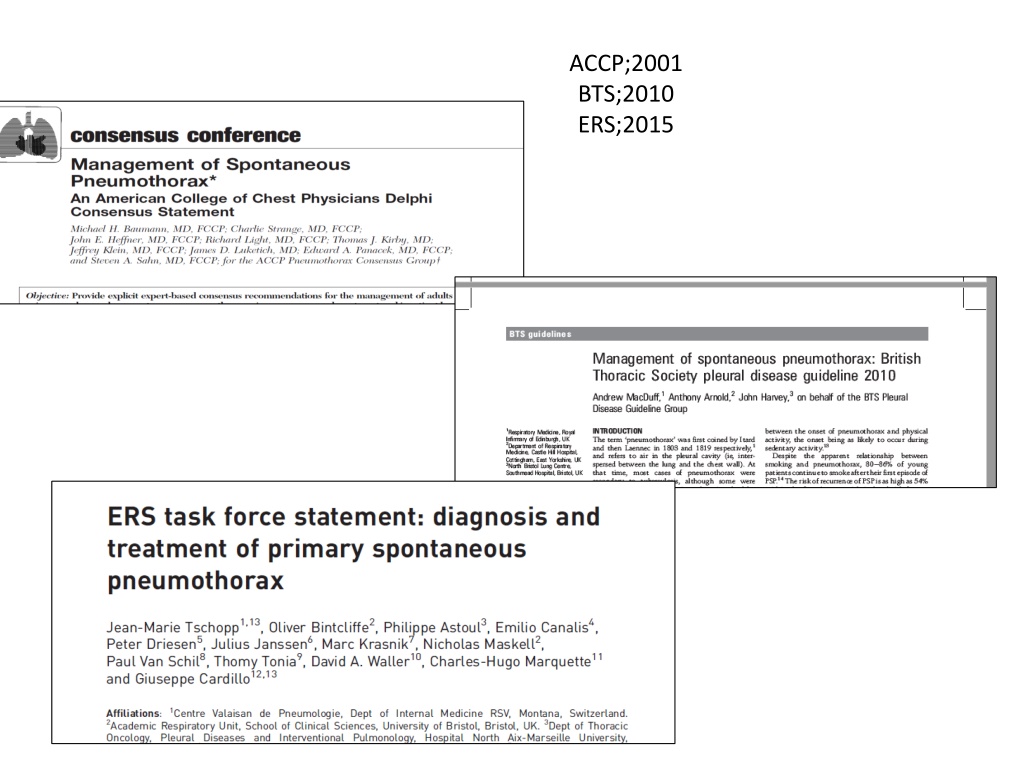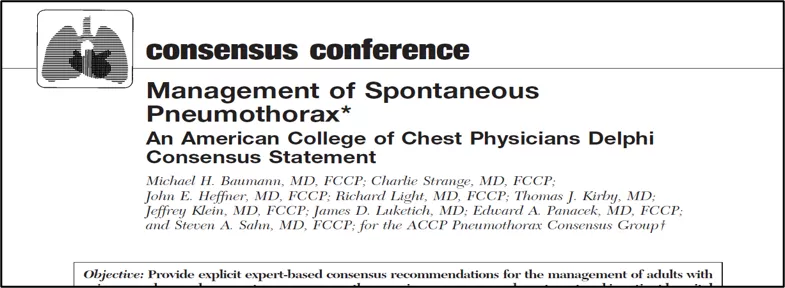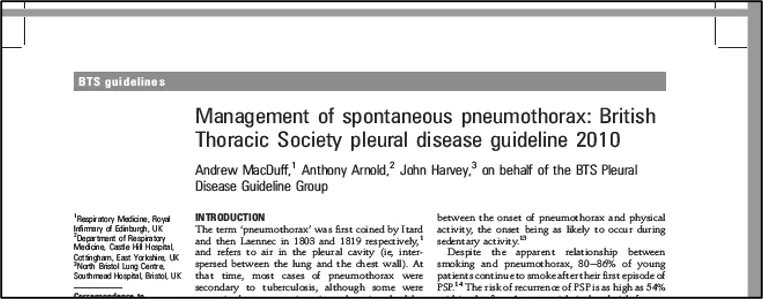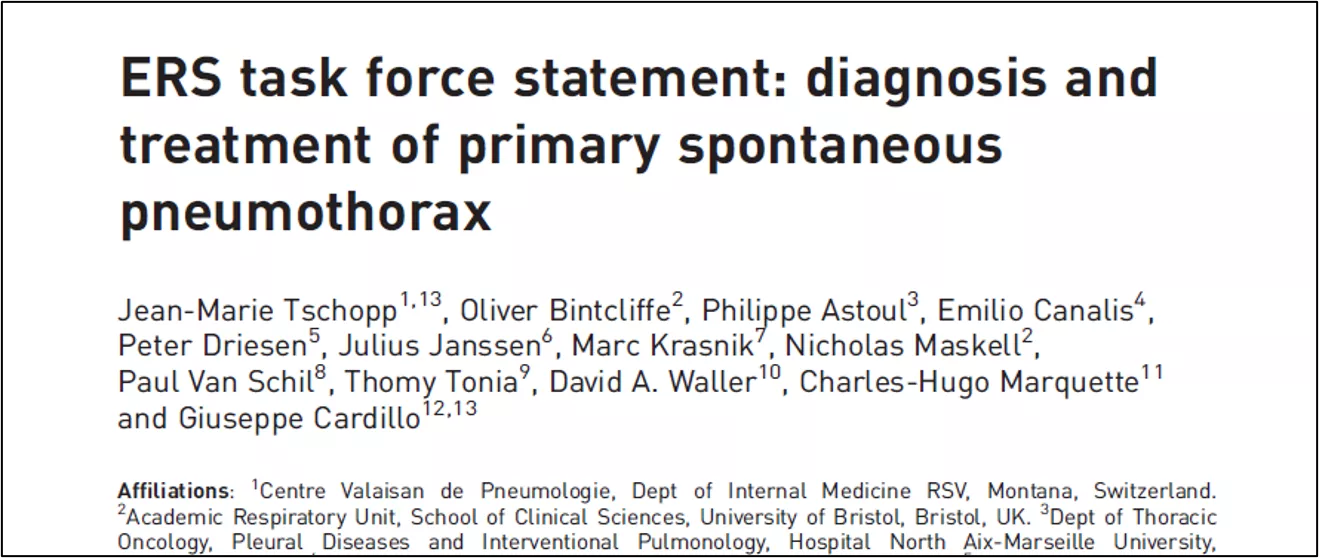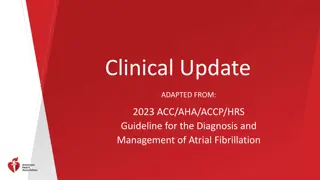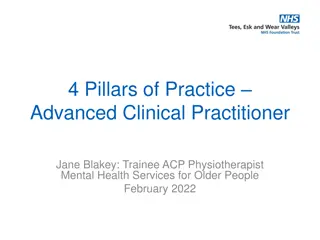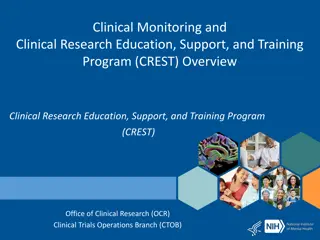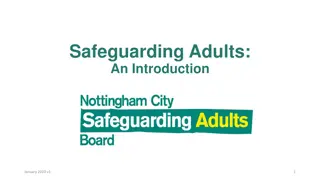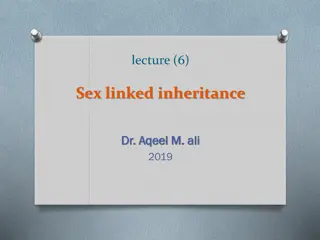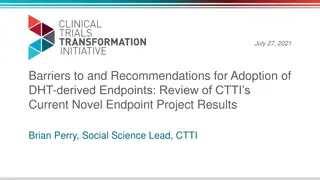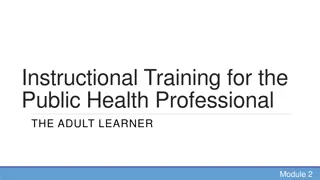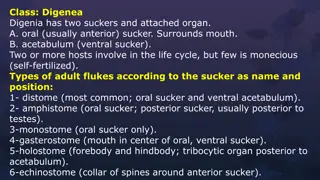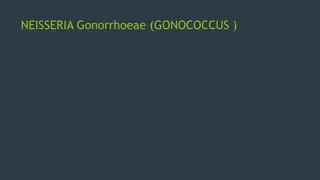Management of Pneumothorax in Adult Males: Clinical Scenarios and Recommendations
In this medical case study, two scenarios of adult males presenting with pleuritic chest pain and pneumothorax are discussed. The first scenario involves a 25-year-old with sudden onset chest pain, while the second scenario involves a 60-year-old with COPD. Recommendations for managing pneumothorax, including pleural aspiration and chest drain insertion, are provided based on the individual patient's history and clinical findings.
Download Presentation

Please find below an Image/Link to download the presentation.
The content on the website is provided AS IS for your information and personal use only. It may not be sold, licensed, or shared on other websites without obtaining consent from the author. Download presentation by click this link. If you encounter any issues during the download, it is possible that the publisher has removed the file from their server.
E N D
Presentation Transcript
ACCP;2001 BTS;2010 ERS;2015
Q1 25 year old male with sudden onset pleuritic chest pain, denies dyspnoea. Sats are 97% on air. CXR shows right sided pneumothorax 2.5cm measured at hilum. How should the pneumothorax be managed? A. B. Pleural aspiration Intercostal chest drain with underwater seal Intercostal chest drain with -8cm water wall suction Admit overnight on 15litres humidified oxygen Discharge with follow up CXR in 1-2 weeks C. D. E.
25 year old male with sudden onset pleuritic chest pain, denies dyspnoea. Sats are 97% on air. CXR shows right sided pneumothorax 2.5cm measured at hilum. How should the pneumothorax be managed? A. B. Pleural aspiration Intercostal chest drain with underwater seal Intercostal chest drain with -8cm water wall suction Admit overnight on 15litres humidified oxygen Discharge with follow up CXR in 1-2 weeks C. D. E. Thorax 2010;65(Suppl 2):ii18-ii31 (page ii21)
Q2 60 year old male present with right sided pleuritic pains and dyspnoea. Sats was 97% on air and CXR shows 1.5cm right side pneumothorax measured at hilum. Pleural aspiration was done and a follow up CXR shows reduction in size of pneumothorax to 0.5cm measured at hilum. This patient is a current cigarette smoker with 20 pack year history. He has a diagnosis of COPD with 2 exacerbation in the past 12 months, one requiring BiPAP for hypercapnic acidaemic respiratory failure. What is the next management step? A. Admit overnight for observation on room air B. Admit overnight on 15Litres oxygen C. Repeat pleural aspiration with 16G cannula D. Treat persistent pneumothorax with 12FG Seldinger intercostal drain. E. Treat persistent pneumothorax with wide bore Argyl drain
60 year old male present with right sided pleuritic pains and dyspnoea. Sats was 97% on air and CXR shows 1.5cm right side pneumothorax measured at hilum. Pleural aspiration was done and a follow up CXR shows reduction in size of pneumothorax to 0.5cm measured at hilum. This patient is a current cigarette smoker with 20 pack year history. He has a diagnosis of COPD with 2 exacerbation in the past 12 months, one requiring BiPAP for hypercapnic acidaemic respiratory failure. What is the next management step? A. Admit overnight for observation on room air B. Admit overnight on 15Litres oxygen C. Repeat pleural aspiration with 16G cannula D. Treat persistent pneumothorax with 12FG Seldinger intercostal drain. E. Treat persistent pneumothorax with wide bore Argyl drain at risk of resp failure no role for repeated pleural aspiration
60 year old male present with right sided pleuritic pains and dyspnoea. Sats was 97% on air and CXR shows 1.5cm right side pneumothorax measured at hilum. Pleural aspiration was done and a follow up CXR shows reduction in size of pneumothorax to 0.5cm measured at hilum. This patient is a current cigarette smoker with 20 pack year history. He has a diagnosis of COPD with 2 exacerbation in the past 12 months, one requiring BiPAP for hypercapnic acidaemic respiratory failure. What is the next management step? A. Admit overnight for observation on room air B. Admit overnight on 15Litres oxygen C. Repeat pleural aspiration with 16G cannula D. Treat persistent pneumothorax with 12FG Seldinger intercostal drain. E. Treat persistent pneumothorax with wide bore Argyl drain at risk of resp failure no role for repeated pleural aspiration
Q3 58 year old male presents with pleuritic type chest pains and dyspnoea. Current smoker of 10 cig daily. Previously diagnosed with asthma with only PRN inhalers-no exacerbation this year. RR 20, sats 95% on air, bp 120/70, pulse 100 regular. examination: tympanic percussion note on right side, reduced breath sounds CXR: 1.4cm pneumothorax measured at hilar level Next step in management? A. Admit, observe overnight B. Admit, 15 litres oxygen overnight C. Aspirate with cannula D. Discharge with follow up CXR next week E. Seldinger intercostal drain
58 year old male presents with pleuritic type chest pains and dyspnoea. Current smoker of 10 cig daily. Previously diagnosed with asthma with only PRN inhalers-no exacerbation this year. RR 20, sats 95% on air, bp 120/70, pulse 100 regular. examination: tympanic percussion note on right side, reduced breath sounds CXR: 1.4cm pneumothorax measured at hilar level Next step in management? Small volume Secondary spontaneous pneumothorax A. Admit, observe overnight B. Admit, 15 litres oxygen overnight C. Aspirate with cannula D. Discharge with follow up CXR next week E. Seldinger intercostal drain Aspiration, post procedure CXR, if smaller, admit for observation then discharge If post procedure CXR unchanged-intercostal drain
Q4 25 year old presents with rapid onset right side chest pains. CXR shows right sided pneumothorax and undergoes needle aspiration of 2 litres. Post procedure CXR shows a very small apical pneumothorax and was discharged with clinic follow up. Prior to discharge he informs you that he is due to fly out to Ibiza in 4 weeks time for a holiday. How long after radiological resolution of a primary spontaneous pneumothorax should the patient refrain from air travel? A. B. C. D. E. 1 day 1 week 1 month 1 year Air travel contraindicated in spontaneous pneumothorax
25 year old presents with rapid onset right side chest pains. CXR shows right sided pneumothorax and undergoes needle aspiration of 2 litres. Post procedure CXR shows a very small apical pneumothorax and was discharged with clinic follow up. Prior to discharge he informs you that he is due to fly out to Ibiza in 4 weeks time for a holiday. How long after radiological resolution of a primary spontaneous pneumothorax should the patient refrain from air travel? A. B. C. D. E. 1 day 1 week 1 month 1 year Air travel contraindicated in spontaneous pneumothorax Thorax 2010;65(Suppl 2):ii18-ii31 (page ii23)
Q5 45 year old male has travelled to Sharm El-Sheikh, Egypt for a scuba diving holiday. Whilst there, he was involved in a road bicycle collision and sustained a pneumothorax. He was treated with a chest drain and full re-expansion achieved. When would he be safe to fly back home to UK in a commercial plane? A. 2 days following resolution of traumatic pneumothorax 2 weeks following resolution of traumatic pneumothorax 2 months following resolution of traumatic pneumothorax 2 years following resolution of traumatic pneumothorax Banned from flying due to traumatic pneumothorax B. C. D. E.
45 year old male has travelled to Sharm El-Sheikh, Egypt for a scuba diving holiday. Whilst there, he was involved in a road bicycle collision and sustained a pneumothorax. He was treated with a chest drain and full re-expansion achieved. When would he be safe to fly back home to UK in a commercial plane? A. 2 days following resolution of traumatic pneumothorax 2 weeks following resolution of traumatic pneumothorax 2 months following resolution of traumatic pneumothorax 2 years following resolution of traumatic pneumothorax Banned from flying due to traumatic pneumothorax Ideally 2 weeks -based on relative low grade evidence B. C. D. E. Thorax 2011;66:i1-i30 (page i6) Managing passengers with stable respiratory disease planning air travel: British Thoracic Society recommendations
Q6 45 year old male has travelled to Sharm El-Sheikh, Egypt for a scuba diving holiday. Whilst there, he was involved in a road bicycle collision and sustained a pneumothorax. He was treated with a chest drain and full re-expansion achieved. When is he safe to dive? A. after successful Video assisted thoracoscopic surgery (VATS) 2 weeks after resolution of traumatic pneumothorax after bilateral surgical pleurectomy and associated with normal lung function and normal thoracic CT scan performed after surgery after traumatic pneumothorax healed and demonstrated normal lung function including flow volume loop and normal thoracic CT scan scuba diving contraindicated due to traumatic pneumothorax B. C. D. E.
45 year old male has travelled to Sharm El-Sheikh, Egypt for a scuba diving holiday. Whilst there, he was involved in a road bicycle collision and sustained a pneumothorax. He was treated with a chest drain and full re-expansion achieved. When is he safe to dive? inappropriate, 5-10% recurrence rates commercial flight A. after successful Video assisted thoracoscopic surgery (VATS) 2 weeks after resolution of traumatic pneumothorax after bilateral surgical pleurectomy and associated with normal lung function and normal thoracic CT scan performed after surgery after traumatic pneumothorax healed and demonstrated normal lung function including flow volume loop and normal thoracic CT scan scuba diving contraindicated due to traumatic pneumothorax B. C. spontaneous pneumothorax, not traumatic D. E.
Q7 80 year old COPD patient admitted to day case for scheduled CT guided percutaneous lung biopsy of 1.6cm left lower lobe mass lesion. Procedure was complicated by significant coughing fits during after the procedure and subsequently developed haemoptysis. CXR 4 hours post procedure was done at 16:00 and is shown. What is the next step in management? A. B. C. D. E. Discharge, clinic next week Admit for observation Pleural aspiration Seldinger intercostal drain Wide bore Argyl drain
80 year old COPD patient admitted to day case for scheduled CT guided percutaneous lung biopsy of 1.6cm left lower lobe mass lesion. Procedure was complicated by significant coughing fits during after the procedure and subsequently developed haemoptysis. CXR 4 hours post procedure was done at 16:00 and is shown. What is the next step in management? A. B. C. D. E. Discharge, clinic next week Admit for observation Pleural aspiration Seldinger intercostal drain Wide bore Argyl drain Management of Spontaneous Pneumothorax 2010;65(Suppl 2):ii18-1131
80 year old COPD patient admitted to day case for scheduled CT guided percutaneous lung biopsy of 1.6cm left lower lobe mass lesion. Procedure was complicated by significant coughing fits during after the procedure and subsequently developed haemoptysis. CXR 4 hours post procedure was done at 16:00 and is shown. What is the next step in management? 80 year old admitted for biopsy. Post procedure CXR shows: A. B. C. D. E. Discharge, clinic next week Admit for observation Pleural aspiration Seldinger intercostal drain Wide bore Argyl drain Management of Spontaneous Pneumothorax 2010;65(Suppl 2):ii18-1131
Q8 68 year old female admitted for cancer 2ww surgery for bowel cancer and is needing central venous access. Right internal jugular vein cannulation was attempted with difficulty and then patient complained of rapid onset dyspnoea and right side pleuritic pain. CXR showed 1.4cm right pneumothorax, satisfactory central line tip position. Surgical team wishes to press on with scheduled laparotomy. What do you suggest as management plan? A. Pleural aspirate B. Postpone surgery, observe overnight with 15litres oxygen C. Postpone surgery, observe overnight on room air D. Seldinger drain and proceed with cancer surgery E. Wide bore Argyl drain and proceed with cancer surgery
68 year old female admitted for cancer 2ww surgery for bowel cancer and is needing central venous access. Right internal jugular vein cannulation was attempted with difficulty and then patient complained of rapid onset dyspnoea and right side pleuritic pain. CXR showed 1.4cm right pneumothorax, satisfactory central line tip position. Surgical team wishes to press on with scheduled laparotomy. What do you suggest as management plan? Iatrogenic pneumothorax Less than 2cm probably doesn t matter A. Pleural aspirate B. Postpone surgery, observe overnight with 15litres oxygen C. Postpone surgery, observe overnight on room air D. Seldinger drain and proceed with cancer surgery E. Wide bore Argyl drain and proceed with cancer surgery Need mechanical ventilation for surgery therefore need treating with intercostal drain, Seldinger would suffice
Q9 60 year old male with copd, current cigarette smoker admitted for exacerbation. CXR shows 1.8cm left pneumothorax and therefore treated with Seldinger 12FG intercostal drain. On day 3 of hospital admission the drain remains swinging and bubbling. When should you involve the thoracic surgeon? A. On first presentation to hospital with pneumothorax B. Persistent air leak beyond 4 days C. After 2 days of bubbling chest drain D. After 2 days of unsuccessful wall suction aiming for -12cm water E. After unsuccessful talc pleurodesis
60 year old male with copd, current cigarette smoker admitted for exacerbation. CXR shows 1.8cm left pneumothorax and therefore treated with Seldinger 12FG intercostal drain. On day 3 of hospital admission the drain remains swinging and bubbling. When should you involve the thoracic surgeon? A. On first presentation to hospital with pneumothorax Persistent air leak beyond 4 days After 2 days of bubbling chest drain After 2 days of unsuccessful wall suction aiming for -12cm water After unsuccessful talc pleurodesis B. C. D. E.
Q10 The following are risk factors for developing persistent air leaks following pneumothoraces, except: A. B. C. D. E. Female gender Lower diffusion capacity of lung for CO History of smoking Diabetes mellitus Chronic steroid use
The following are risk factors for developing persistent air leaks following pneumothoraces, except: A. B. C. D. E. Female gender Lower diffusion capacity of lung for CO History of smoking Diabetes mellitus Chronic steroid use Others: COPD, lower FEV1 (diffusion capacity CO would be risk factors in persistent air leak after LVRS) Chest. 2017 Aug; 152(2): 417-423 Management of Persistent Air Leaks
Q11 In chemical pleurodesis, the following have been used as sclerosants to cause inflammatory response in pleural space, except: A. Doxycycline B. Tetracycline C. gold D. Silver nitrate E. Low virulence strain S.pyogenes incubated in benzylpenicillin
In chemical pleurodesis, the following have been used as sclerosants to cause inflammatory response in pleural space, except: Talc: most common, most effective Bleomycin: high cost, toxicity A. Doxycycline B. Tetracycline C. gold D. Silver nitrate E. Low virulence strain S.pyogenes incubated in benzylpenicillin
